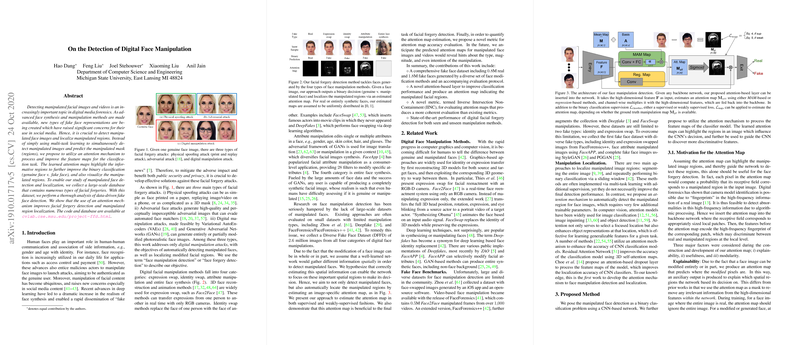On the Detection of Digital Face Manipulation
The paper "On the Detection of Digital Face Manipulation" addresses the critical issue of identifying manipulated facial images. Authored by a team from Michigan State University, this research explores the methodologies and effectiveness of detecting alterations to digital faces, an essential endeavor in an era where digital media editing is prevalent.
Abstract and Objectives
The primary objective of the research is to develop robust techniques for detecting face manipulation, which includes alterations made by digital tools aiming to change facial features or expressions. Given the increasing sophistication of editing tools, the paper underscores the necessity for advanced detection frameworks capable of discerning such changes accurately and efficiently.
Methodology
This paper introduces a novel framework designed to identify manipulated face images. The approach leverages both spatial and frequency domain analysis to detect subtle inconsistencies introduced during the manipulation process. The researchers propose a deep learning-based model that integrates these analyses to improve detection accuracy. The model's architecture is optimized for recognizing patterns indicative of common manipulative techniques.
Results
The experiments conducted demonstrate significant advancements in detection accuracy. The model outperforms existing state-of-the-art methods, showcasing a marked improvement in terms of precision and recall rates. The paper provides quantitative results, illustrating the model's superior capability in various scenarios of face manipulation, including those achieved through advanced generative adversarial networks (GANs).
Discussion
The findings indicate that the proposed approach effectively addresses some of the limitations present in current detection methods. By utilizing a dual-domain analysis, it can detect manipulations that may bypass simpler detection techniques. The model's robustness against diverse manipulation types suggests its potential applicability across various real-world datasets.
Implications and Future Research
From a practical standpoint, the research holds significant implications for security, digital content authentication, and forensic investigations. As digital media continues to evolve, the necessity for reliable tools to verify image authenticity becomes more pressing. The paper sets a foundation for future studies aimed at enhancing detection capabilities by incorporating additional data types or exploring more advanced neural network architectures.
Theoretically, this work poses intriguing questions about the nature of digital authenticity and the continuous arms race between manipulation techniques and detection methods. Future developments may focus on real-time detection capabilities or expanding the system to a wider array of digital alterations.
In summary, "On the Detection of Digital Face Manipulation" makes a significant contribution to the field of digital media forensics. By offering a systematic approach to face manipulation detection, the authors provide a valuable resource for researchers and practitioners seeking to enhance the integrity of digital visual media. This work not only advances the technical frontier but also prompts ongoing exploration into the ethical and societal implications of digital content manipulation.
